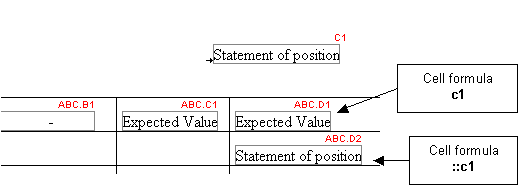Table Relative Operator
The :: operator specifies an absolute reference to document cells, removing any ambiguity between document cells and fields or table cells that are similarly named. The operator is most commonly used in table cell calculations to refer to a cell outside of the table, particularly where you have a table cell and a cell in the body of the document that are named identically except for the table Id prefix. See examples 1 and 2.
The :: would also be used if there were ambiguity between cells in the CaseView document and a Working Papers or Time database referenced in a filter calculation. See example 3 below.
Syntax
Calculation(::cell number)
Example 1
Table cell abc.d2 has a calculation of c1.
Where
Table cell abc.c1 contains the string "expected value", and
Document cell c1 contains the string "Statement of Financial position".
When the :: operator is not used, the function looks within the table first and inserts the contents of cell abc.c1, "expected value".
Example 2
Using the same data as above, table cell abc.d3 has a calculation of ::c1.
When the :: operator is used, the function looks at cells outside the table first, finds document cell c1, and inserts the contents, " Statement of Financial position ".

Example 3
Database filter calculation
LTRIM(AM->SCHEDULE) = ::c1
Where
AM is the trial balance database that contains a field labeled C1, and
c1 is CaseView cell containing a text string.
Use :: before the cell reference to ensure it uses the CaseView cell.
If you are referring to a field in the filter calculation, prefix the field name with the name of the database, as in
LTRIM(AM->SCHEDULE) = AM->C1.
This removes any ambiguity between cell C1 and AM Database field C1.




